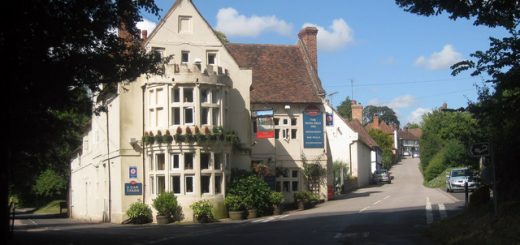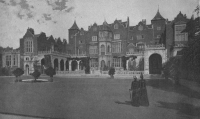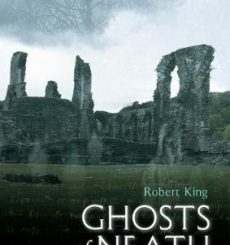Borley Rectory
The haunting of the Borley Rectory during the 1920s and 1930s, is undoubtedly one of the most famous in Britain, as well as being one of the most controversial. There seems to be a consensus among many people that the rectory was never really haunted at all, all phenomena being put down to fraud, misinterpreted natural phenomena, and the will of Harry Price to create an interesting case. The wealth of sightings and experiences by independent witnesses, suggests that although much of the phenomena can be explained in rational terms, a percentage remains which can still be seen as inexplicable at the present time.
History
![Rolldi [Public domain], via Wikimedia Commons](http://www.mysteriousbritain.co.uk/wp/wp-content/uploads/2018/12/Borley_Rectory2-300x188.jpg) The rectory was built in 1863, on the site of an old Benedictine Monastery for the Reverend H.D.E Bull and his family. In 1892 the Reverend Bull died in the Blue Room. Harry Bull then took over from his father until 1927, when he also passed away in the Blue Room, now with a reputation as the haunted room of the house.
The rectory was built in 1863, on the site of an old Benedictine Monastery for the Reverend H.D.E Bull and his family. In 1892 the Reverend Bull died in the Blue Room. Harry Bull then took over from his father until 1927, when he also passed away in the Blue Room, now with a reputation as the haunted room of the house.
After a year standing empty, the Rev Eric Smith and his wife moved in, and lived there for three years. It was during this time that Harry Price stayed over at the house for three days, as part of his long-term investigations. In October 1930, the Rev L.A Foyster and his wife Marianne moved in, and stayed for 5 years. In 1935 (after the Foysters had moved out) the property was leased to Harry Price for a whole year, the results of which were published in The Most Haunted House in England.
The rectory was gutted by fire in 1939 when the occupier, Captain William Gregson, who had bought the property, accidentally turned over an oil lamp near a bookstand. The fire caught hold quickly destroying the rectory beyond repair. The ruin was finally demolished in 1944.
Ghostly sightings, Legends and Strange Phenomena
From around 1885, there were sightings of a ghostly nun in the grounds of the rectory, and poltergeist activity was observed. According to local lore, the ghostly nun was the spirit of a 13th century nun from a local convent, who had fallen in love with a monk from the local monastery. They were said to have fled from the area in a coach and horses. Captured shortly afterwards, they were brought to swift justice; the monk was hanged, and the nun was walled up inside the convent. It is difficult to say whether this story had been around for a long time, or was a result of sightings during the Reverend Bulls tenancy.
What is certain, is that there are a lot of reports of sightings during the time that H.D.E Bull and his son Harry were in residence. In 1886 a nurse is said to have left because of strange phenomena, possibly phantom footsteps. Around 1900, the two sisters of Harry Bull saw the ghostly nun in the garden during the daytime. Many local people were also witness to the spectre.
Mr and Mrs Edward Cooper, who lived in a cottage near to the rectory saw the ghost, and also witnessed a phantom coach and horses. The Bulls must have taken the strange happenings in their stride, as they were in residence until the death of Harry Bull in the Blue Room in 1927. It must be noted that Harry Bull had jokingly remarked that he would return after his death, and make his presence known by throwing mothballs around, he must have had a good sense of humour. In the year after the reverend’s death, in the time when Borley was unoccupied, the ghostly nun was seen several more times by local witnesses.
The next real concentration of reports comes from Eric Smith and his wife. During their short stay they complained of mysterious footsteps, doorbells ringing of their own accord, and phantom stone throwing. In response to this poltergeist phenomena, the reverend phoned the Daily Mirror, who sent along a reporter, and then contacted Harry Price from the SPR. So began his long and controversial association with the rectory.
His first response was to ask permission to stay at the Rectory for a short period of time. While staying there, Price witnessed first hand the poltergeist activity, and is said to have got in touch with a spirit, (The Reverend Bull) while holding a seance in the Blue Room. The phenomena continued and the Smiths, having enough of either the haunting, or the publicity had left by 1930.
The next residents were the Reverend Lionel Foyster, and his wife Marianne Foyster. The strange events within the rectory continued, and the Foysters were witness to poltergeist phenomena, ranging from smashed glasses and stone throwing, to mysterious writing on the walls. Marianne is also said to have been thrown from her bed by a strange force. The strange writing is the most curious part of the phenomena, which defies mistaken identification of natural events, although a rational explanation cannot be ruled out in any circumstance.
 The Foysters left after a five-year stay, and Price now got the opportunity to study the rectory in isolation, with a team of different researchers. Price leased the property from June 1937 to 1938, but the results were relatively disappointing in comparison to what had been observed before. An account of the haunting was published by Price in ‘The Most Haunted House in England’.
The Foysters left after a five-year stay, and Price now got the opportunity to study the rectory in isolation, with a team of different researchers. Price leased the property from June 1937 to 1938, but the results were relatively disappointing in comparison to what had been observed before. An account of the haunting was published by Price in ‘The Most Haunted House in England’.
Even after the rectory had burned to the ground, strange events are still said to have occurred, and there has been relatively recent phenomena observed in the Parish Church.
Harry Price died in 1948, and since then many authors have pulled apart his work at the rectory, explaining all recorded phenomena as misinterpreted natural occurrences, hoaxing and hearsay.
Author Daniel Parkinson




Re: Borley Rectory
I have just finished reading a excellent book The Borley Rectory Companion by P Adams, E Brazil and P Underwood. Wow if you want to read about this infamous haunting then this is the book to read. I just couldn’t put it down. Very well written and impartial.It also contains photographs and diagrams. It was published this year RRP £25, however have a look online for a cheaper deal. This is one of those cases that tends to keep on cropping up so I was looking for a book with a complete outlook on the place and I think this book is just that.Interesting read.
Re: Borley Rectory
There are a few interesting things about the Borley Rectory.
The first is the appearance in press in 2000 of a book named We Faked the Ghosts of Borley Rectory. In this book Louis Mayerling, a young boy at the time, relates how he became fast friend with the Harry Bull’s sons and discovered the whole family was having great fun perpetuating old ghost stories. Mayerling also said the Foysters decided to continue the tradition to enliven the boring country life and even "hired" him to dress in a black cape and walk around the gardens at dusk to play the part of the spectral nun.
The big problem with Myerling’s book is that he relates a seance held at Borley Rectory on Easter 1935, a seance which included such huge names as Sir Montagu Norman, governor of the Bank of England, George Bernard Shaw, the great playwright, and T.E. Lawrence, the immensely popular "Lawrence of Arabia". No other records of this seance remains, very suspicious given the fact that such popular figures were in attendance. During this seance, also attended by Mayerling, paranormal activity was witnessed, including a bright white light which, again according to Mayerling, damaged one of his eyes forever.
Mayerling said he was still "unnerved" by the occurence which, again according to him, sent Norman and Shaw running for their lives. It’s curious he didn’t mention T.E. Lawrence was killed in a tragic motorcycle crash just a few weeks later as being a direct result of the seance.
The second is that researches among the surviving servants of the Bull family yielded confirmation that either the Bulls were incredibly skilled at scaring people or there was indeed something sinister going on. Several former maids testified they had remained in the Rectory for only a few days before being driven away by strange occurences which includes hoarse, inaudible whispers, a moaning female voice, being pelted with pebbles and keys dislodging from their locks. A former gardener related how he and his wife heard heavy footsteps in their room, located over the stables, every night for eight months, until they had about enough and decided to leave.
Finally I have in my possession an old book with pictures of the strange messages written on the walls of Borley rectory. I hope to be able to scan and present them to the website in the near future.
Re: borley rectory
After many years interest in Borley I finally visited the site in the summer of 1988. A very sceptical friend came with me who had little interest in the whole thing.(we were on holiday in Hopton on Sea at the time.) We stopped to talk to a man from one of the bungalows and he told us he had they keys to the church if we would like to have a look. I really enjoyed seeing all the photos of the Bulls. My friend idly looked round and happened to gently touch the large bible at the front of the church. In their owns words they felt "like a bolt of lightening had struck me!" After making a quick exit my friend was visiblyshaken and refused to go back in the church. So there is definately something at Borley, without any doubt.
Re: Borley Rectory
The widow of Borley is well worth reading as there is no doubt Marianne Foyster faked some of the things to liven up boring rural England! However it does not mean that everything was faked. There was certainly a core of inexplicable happenings occuring in and around the rectory.